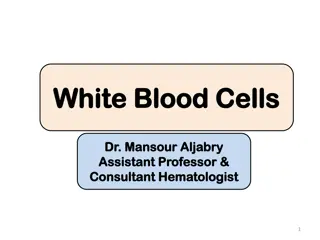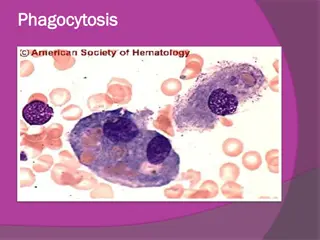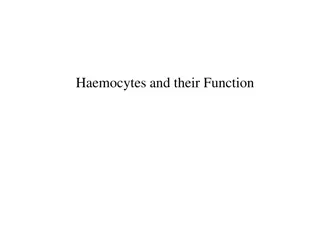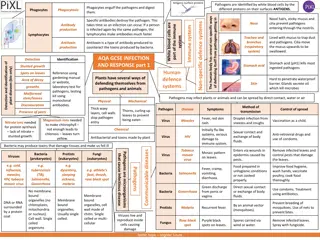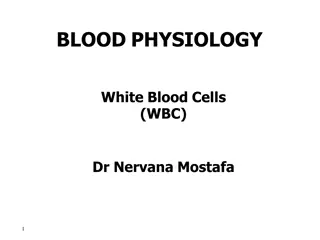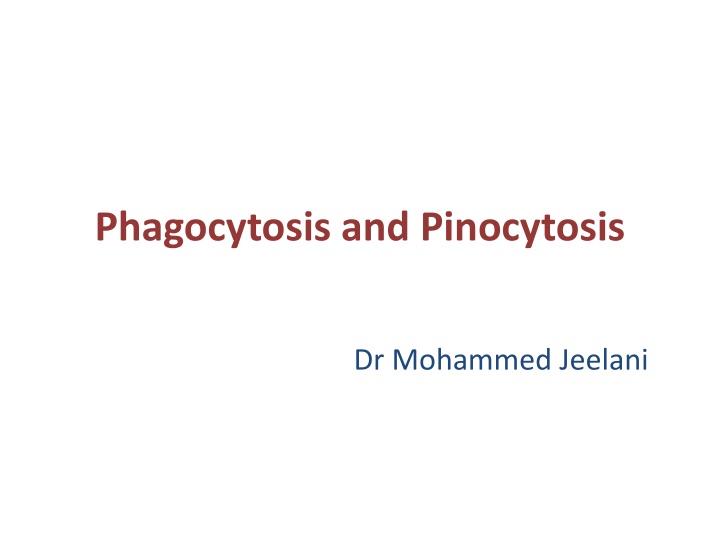
Phagocytosis and Pinocytosis in Cellular Processes
Explore the concepts of phagocytosis and pinocytosis, key processes in cellular biology. Understand their functions and learn how white blood cells play a crucial role in immune responses. Discover the intricacies of margination, diapedesis, chemotaxis, opsonisation, attachment, and engulfment stages in phagocytosis. Enhance your knowledge with visual aids and detailed explanations provided by Dr. Mohammed Jeelani.
Download Presentation

Please find below an Image/Link to download the presentation.
The content on the website is provided AS IS for your information and personal use only. It may not be sold, licensed, or shared on other websites without obtaining consent from the author. If you encounter any issues during the download, it is possible that the publisher has removed the file from their server.
You are allowed to download the files provided on this website for personal or commercial use, subject to the condition that they are used lawfully. All files are the property of their respective owners.
The content on the website is provided AS IS for your information and personal use only. It may not be sold, licensed, or shared on other websites without obtaining consent from the author.
E N D
Presentation Transcript
Phagocytosis and Pinocytosis Dr Mohammed Jeelani
Specific learning outcomes Outline pinocytosis and phagocytosis Explain the functions of pinocytosis and phagocytosis
Eg: White Blood Cells, which are part of the immune system, surround and engulf bacteria by endocytosis.
Phagocytosis Process by which solid particulates like bacteria, dead tissue or other bits of microscopic materials are engulfed and destroyed by cells termed as Phagocytes .
Phases Margination Diapedesis Chemotaxis Opsonisation & Attachment Engulfment Degranulation (secretion) Degradation/ killing
Margination In the area of infection , the phagocyte get attached towards the capillary endothelium and start rolling along its surface Margination. Cell adhesion molecules
Diapedesis The marginated phagocytes are traveling in large number from the blood at the site of infection & these phagocytes can squeeze through the pores of the blood capillaries by diapedesis
Chemotaxis Chemical substances produced by the causative agent will attract the phagocyte towards the site of injury called chemotaxis
Opsonisation and Attachment Opsonins ( plasma factors like Ig G & complement protein C3 ) coat the bacteria to make them tasty to phagocyte called opsonisation The coated bacteria then binds to cell membrane of phagocyte called attachment
Engulfment Phagocyte project pseudopodia in all direction around the opsonized particle . Pseudopodia meet each other on opposite side form phagocytic cap It breaks away from the membrane forming a phagocytic vesicle Then lysosomes of the cell fuse with the phagocytic vesicle to form Phagolysosome
Degranulation Lysosomes pour their enzymes into the vesicle Proteolytic enzymes digest microbes Indigestible products remain in the vesicle called residual body Contents of residual body are excreted out of the cell by exocytosis
Degradation or Killing Defensins alpha & beta (bactericidal agents) Myeloperoxidase converts chloride , bromide & iodide ions to their corresponding acids which are potent oxidants which help in killing the bacteria. Free radical O2- & H2O2
Pinocytosis Cell drinking Process of engulfing liquid substances by the enfolding of cell membrane Eg: Reabsorption by renal tubular epithelial cells
Functions Destroy harmful foreign particles, bacteria and dead cells. Defense (immunity) essential for fighting infections Transport absorption of extracellular fluids (ECF)
Reference Indu khurana. Medical physiology for UG, 1st edition, Elsevier publication chapter 1.3 page 23, chapter 3.3 pge 126-127












